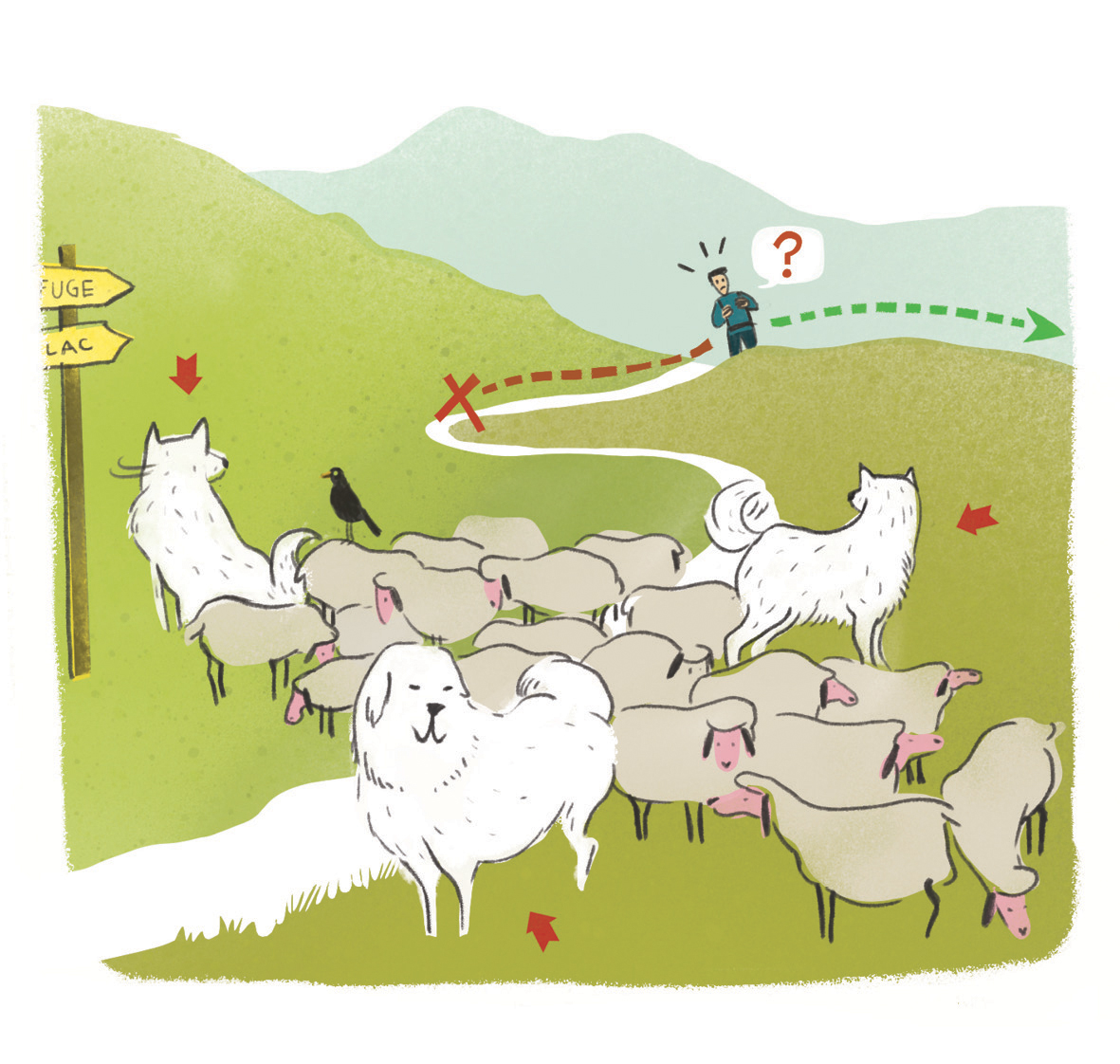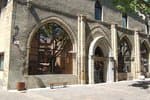Morgon loop
16 points of interest
 Flora
FloraBoscodon national forest
Covering almost 900 hectares in the ubac between 1150m and 2316m, it is criss-crossed by the Infernet, Bragousse and Colombier torrents, which form the Boscodon alluvial cone with its devastating floods.
The forest was managed by monks for 650 years: trees were towed to the Durance where they were assembled into rafts to float down to the Rhône. Over-exploited after the monks stopped managing, it has been painstakingly restored: its high quality and biodiversity have earned it Natura 2000 status and the "exceptional forest" label. Fauna
FaunaDeer
Deer are abundant in the forest of Boscodon but since they are forest-dwellers by nature it is difficult to spot them, although a few clues may betray their presence. Maybe the heart-shaped imprints of their delicate hooves or tree trunks with their bark stripped away by the rubbing of a young buck's antlers to remove the last shreds of velvet. You might also see them in a clearing. Fauna
FaunaBlack Grouse
In Springtime, the male, whose black feathers and lyre shaped tail contrast with its white rump, make spectacular displays to attract the females. Between the larches and junipers, in the high grass is favourable environment for these birds to reproduce, but we have to take in to account the flocks of sheep and the progressive end of this kind of environment.
 Fauna
FaunaChamois
Early in the morning and late in the evening, the chamois come to graze around the Tête de la Vieille, du Pic de Charance or on the other side of the Pic Jean Martin on the edge of the cirque de Bragousse. This emblematic Alpine animal has a particularly well developed sense of smell and hearing which makes it difficult to approach it. So it is easier to observe it through binoculars... which also preserves its tranquility!
 Flora
FloraForest flora
In the forest, there are a few colonies of Lady's-slipper orchids (also known in French as "sabot de Venus" or Venus' slipper), a species that is as brilliant as it is rare. Please do not pick any of them, so as to protect them and allow others to enjoy them. There is also the very diminutive moss, Buxbaumia viridis or green shield-moss, on decomposing stumps.
 Fauna
FaunaMarmots
The Alpine marmot is naturally present in the high-mountain grasslands. This large rodent is only active above ground from April to October, and in the cold season it retires to hibernate in its burrow. They live in family groups, respecting a strict hierarchy. Through playing, grooming, fighting and biting one dominant pair maintains its position, ensuring group cohesion. Each individual contributes to marking the boundaries of the group's territory, by rubbing its cheeks on rocks and leaving droppings and urine. When danger threatens, the marmot utters a loud, high-pitched whistle to warn its companions.
 Pastoralism
PastoralismPreserved Pasture
The Morgon cirque welcomes a flock of 1300 sheep. At the height of the tourist season, it migrates towards the pastures at Vallon Clapier and Olettes more to the East. This is due to agro-environmental measures, a contract between the Pastoral Organization and the Ecrins National Park which seeks to protect pastoral resources and the environmental assets of the pasture.
 Fauna
FaunaWolf
Although the species had been eradicated in France at the beginning of the 20th century, about 400 wolves remained in 1980 in Italy. Today thanks to the protection that it benefits from this large carnivore is settling more and more in the North... It regularly comes to the pasture in the summer creating some damage which has been noted by the park rangers in the National Park and compensated for. The presence of the shepherd and his « dogs » is however dissuasive.
 Fauna
FaunaRock Ptarmigan
It is sometimes possible to see the Rock Ptarmigan on the ridges of the shale slopes which, after having picked their way through the rocks, fly away in a flash of white. It is one of the most threatened species in the Alps... With global warming, evolution in the pastures, winter frequentation ... the future seems uncertain for this inhabitant of the ridges...
 Fauna
FaunaGriffon Vulture
The Pic de Morgon is used by the vultures coming from the right bank of the Durance, sometimes in large numbers, to get up to altitude after having crossed over Serre-Ponçon Lake. Scavengers exclusively , these gravediggers who have frightened and disgusted mankind for a long time hold a fundamental place in the food cycle by rapidly eliminating cadavers and in this way limiting the dispersal of microbes and illness.
 Panorama
PanoramaSummits and vallies
The summit of the Pic de Morgon offers a magnificent view over the Ubaye and the Durance. While on the right bank of the latter, one can see the Aiguilles de Chabrières, the Piolit and the Mont Guillaume, on the left bank of the Ubaye, you can see the Dormillouse. Near to the Pic de Morgon, is the Tête de la Vieille, le Pic de Charance and the Pic Jean Martin. In the distance, you can distinguish the Pic de Bure as well as the snowy summits of the Ecrins and the Vanoise.
 Flora
FloraFlora at altitude
On the ridges, la Berardia Subacaulis, rare and protected, resembles plants found in the desert. Its grey-green cottony rosette is unusual up here on the slopes where we also find the Rose Daphne with its suprizing fragrance. On the limestone the Silver Edged Primrose grows, a Southern plant which is recognizable by its divided leaves edged in silver.
 Fauna
FaunaAvifauna on the cliff
The North face of the Pic de Morgon, with its cliffs, is a perfect place to watch the rock birds... You can see the aerial acrobatics of the Red Billed Chough, which breaks the silence with its strident cry, which is almost metallic. You can also observe the rapid flight of a group of Alpine Swifts and that of those that look like butterflies the Wall Creepers with their legs and curved claws enabling them to cling on to the cliff.
 History
HistorySaint Pierre sanctuary
From time immemorial, the « chapel » situated near to Morgon Lake is the goal of a pilgrimage which takes place every 29th June, Saint-Peter’s day. The practice of this pilgrimage probably goes back to Pagan times; witnessing these impressive stone boulders which may have been used as sacrificial altars... Of this sanctuary, which has been abandoned since the beginning of the 20th century only a few roughly cut rocks remained. However it was identically rebuilt in June 1992 by the students at the Ecrins Technical College. Since then, festivities are held there once more every June.
 Fauna
FaunaCommon Frog
The only amphibious frog living at altitude, it reproduces in Morgon lake before this dries up. Well versed in inhabiting these glacial waters where it hibernates without too much danger, it has a stocky body about 10 cm long, beige with brown markings and a short face topped with golden coloured, protruding lidded eyes.
 Fauna
FaunaEurasian pygmy owl
The smallest owl in Europe lives and breeds in the forest above the Fontaine de L'Ours. There are fewer than 1,000 pairs in France. But in late summer, you can hear its distinctive call.
Description
- From the car park, continue along the Sentier des Pyramides, passing 3 wooden bollards blocking the road. Continue straight ahead, leaving the track to take the path. Pass the Aiguillas lookout to reach the Pyramides lookout. From here, continue downhill on the path until you cross the stream. Continue along the path until you come to a track. Continue along the track for 1 km until you reach a crossroads.
- From here, take a left fork up the path. At the Grand Clos car park, cross the car park and go through the barrier to continue along the track. When you reach the gates of Morgon, continue straight ahead downhill on the footpath, then turn left at the next crossroads. Stay on the path until you reach the summit of the Morgon.
- Descend from the summit for 100m then fork right on the path until you reach the ridges. After the handrail, go left down the path as far as the lake. Circle it to the left to reach the uphill path.
- At the pass turn right, then at the intersection take a left fork onto the balcony path. Stay on the path on the descent, taking a number of switchbacks. When you reach an interpretation panel on the Pic Noir, continue straight ahead to reach the car park at the Fontaine de l'ours.
- Departure : Fontaine de l'Ours, Crots
- Arrival : Fontaine de l'Ours, Crots
- Towns crossed : Crots, Savines-le-Lac, and Pontis
Altimetric profile
Recommandations
- Use appropriate equipment .
- Wear clothing suited to the terrain and weather conditions (windbreaker, gloves, hat...)
 In mountain pastures, protection dogs are there to protect the herds from predators (wolves, etc.).
In mountain pastures, protection dogs are there to protect the herds from predators (wolves, etc.).
When I hike I adapt my behavior by going around the herd and pausing for the dog to identify me.
Find out more about the actions to adopt with the article "Protection dogs: a context and actions to adopt".
Tell us about your meeting by answering this survey.
Information desks
Tourist office Chorges
Grand rue, 05230 Chorges
October to may : Monday to Saturday, 9.00 - 12.30 & 13.30 - 17.00.
April, may, june & september : Monday to Saturday, 9.00 - 12.30 & 14.30 - 18.00
July and August : Monday to Saturday, 9:00 – 12.30 & 14.30 – 19.00 Sunday 9.30 – 12.30
Closed on Thursdays outside French holidays’ periods
Closed on French national holidays, except 14th of July and 15th of August
Tourist office Savines-le-Lac
9 Avenue de la Combe d'Or, 05160 Savines-le-Lac
October to march : Monday to Saturday, 9.00 - 12.30 & 13.30 - 17.00.
April, may, june & september : Monday to Saturday, 9.00 - 12.30 & 14.30 - 18.00
July and August : Monday to Saturday, 9.00 - 13.00 & 15.00 - 19.00. Sundays, 10.00 - 13.00 & 15.00 - 18.00
Closed on French national holidays, except 14th of July, and 15th of August
Closed on Thursdays outside French holidays’ periods
Tourist office Embrun
Place Général Dosse - BP 49, 05202 Embrun
October to march : Monday to Saturday, 9.00 - 12.30 & 13.30 - 17.00.
April, may, june & september : Monday to Saturday, 9.00 - 12.30 & 14.30 - 18.00
July and August : Monday to Saturday, 9.00 - 19.00. Sundays, 10.00 - 12.30 & 16.00 - 19.00
On French national holidays (except 14th of July and 15th of August) : 9am to 1pm. Closed on the 1st of January, 1st of May, 25th December and 11th November
Closed on Thursdays outside French holidays’ periods
Access and parking
Parking :
More information
Source

Report a problem or an error
If you have found an error on this page or if you have noticed any problems during your hike, please report them to us here:


